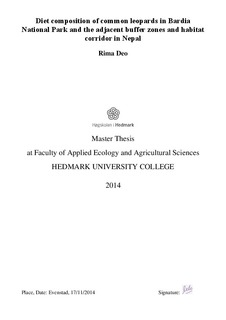| dc.description.abstract | The common Leopard (Panthera pardus) is the most widely distributed species among the large felids. It is a great challenge to manage their depredation on livestock at global level. In this study, I examined spatiotemporal patterns of leopard diet composition in Bardia National Park, Nepal, the buffer zones surrounding the park and a recently established habitat corridor that extends towards a protected area in India. Based on analyses of leopard scat contents, I investigated how the proportions of three main prey categories, i.e. wild ungulates, domestic animals and smaller wild prey, differed between the park, buffer zones and the corridor. I also investigated how diet composition had changed over time by comparing my data (from 2013) with scat content data that were collected during 2000, prior to the establishment of the corridor. Spatially, scats were distributed mainly along the border of the national park (28), the buffer zones (24), and in the corridor (21). Only two scats were found further than 500 m inside the park. Out of 63 scats with recognizable content (10 scats contained only grass, soil or bone fragments and were omitted from the analyses), 29 (46%) were from wild ungulates (26 chital (Axis axis) and 3 nilgai (Boselaphus tragocamelus)) and 12 (19%) contained smaller wild mammals and birds. Among these, 3 were rhesus monkey (Macaca mulatta) and 3 were langur (Semnopithecus hector). Twenty-two scats (35%) contained domestic animals, i.e. 14 goat, 5 pig and 3 sheep. Statistical analysis (G-test) showed no significant differences in diet composition between scats collected during 2013 within the national park and outside in the buffer zones and corridor. This was evident both when grouping the prey items into three categories (i.e. ungulates, domestic and other; G= 0.201, DF=2, P=0.905), and when grouping the prey into two categories (i.e. wild prey and domestic prey; G=0.191, DF=1, P=0.662). However, there was a significant difference in composition of scats collected in 2000 and 2013 when using two prey categories (Wild and domestic; G=3.976, DF=1, P=0.0462).Scat samples from 2013 contained 64% goat, 23% pig, 14% sheep and no calves, and these proportions were almost identical as reported losses among 161 interviewed households (i.e. 65% goat, 22% pig, 10% sheep and 3% calves. The similarity of the results indicate that the scat analyses were reliable, and also identify goats as the most commonly killed domestic prey. I suggest two explanations to the lack of difference in composition of scats collected inside and outside the national park. Firstly, the two parts of the study area were relatively small, and leopards may have moved between them. Secondly, scats found within the park were located near the park border, thereby suggesting that these leopards may have moved frequently outside to feed on domestic animals. The difference between scats collected in 2000 and 2013 was mainly due to an increase in consumption of domestic animals. This may indicate that leopards are more in contact with humans following the establishment of the habitat corridor. This study and other studies have shown that leopards are highly opportunistic animals that commonly consume domestic prey when they are available. Hence, conservation efforts aimed at connecting protected areas should take into account that an increased distribution of wild carnivores is likely followed by elevated conflicts with humans. | nb_NO |
